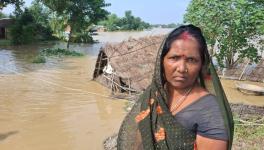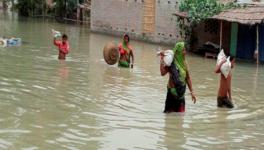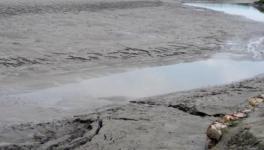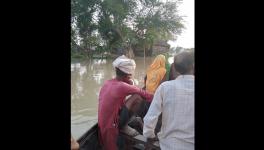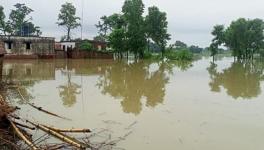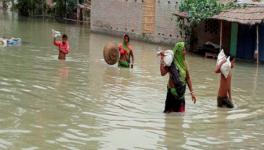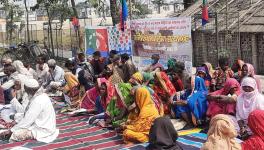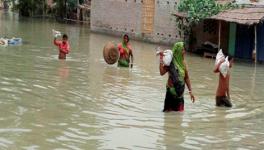Villagers Within Kosi Embankments Suffer ‘Kalapani of Development’
Representational use only.Image Courtesy:Flickr
Patna: Neglected and deprived of their rights for decades, lakhs of people living within Kosi River’s embankments in Bihar’s Supaul district face the fury of floods annually. According to a latest report, they are the victims of injustice caused by policy choices.
As per People’s Commission on Kosi Basin report, released in Patna on Friday, the embankment are spread on 120,000 hectares, and 9.88 lakh people in 380 villages live on the Indian side (as per the 2011 census) while 1.5 lakh people live in 34 villages in Nepal.
Annual floods massively impact the residents of these Bihar villages due to the lack of proper rehabilitation or land reallocation. Every person’s house has been eroded dozens of times due to perennial floods. The ones who were rehabilitated lost their lands to encroachers.
“The Kosi Victims Development Authority was formed in 1987 for the welfare of victims of the Kosi floods. Despite filing multiple RTI applications, the organisation could not be located. A sub-health centre is not working for them. Death during childbirth is common. The condition of education is also pathetic. It will not be an exaggeration to designate their living area as Kalapani of development,” the report says.
“The ground level between the embankments is rising due to the accumulation of silt. With floods becoming more extreme, the sediment mass is going to increase. Construction of safety dams and bridges at many places has reduced the river’s width.” Consequently, “pressure on the embankments and safety dams is increasing. It is likely to take a cataclysmic form in the future”, the report adds.
The Commission points out that high sediment yield is the most critical problem in the Kosi Basin, which, in turn, plays a role in river-related hazards such as river migration and floods.
Therefore, an “integrated multi-hazard approach using the catchment context of sediment production and transport is required for a long-term solution”. The report says it should focus on treating the cause rather than the ‘symptoms’ of the problem.
“Sediment dredging or desilting plans for the Kosi Basin must be evidence-based, e.g., identification of hotspots of aggradation or superelevated reaches. Strategic dredging of sediments from several reaches along the Kosi may be necessary to increase the water-holding capacity and lower the flood risk.”
However, as per current international practice, dredging or de-siltation in the river channel should have a scientific rationale and be planned in such a way that its minimal disturbance to the hydro-geomorphic regime and riverine biodiversity.
It further cautions that the change in the nature of flood and drought due to climate change would likely lead to significant tragedy for the people trapped in the Kosi embankments.
The Bhimnagar Barrage and the embankments were built as a short-term project only for 25 years and are already 60 years old. “Instead of evaluating them, newer technical interventions are worsening the situation. The increasing risks have to be assessed,” the report points out.
The report recommends that all the people living in the middle of the embankment who are deprived of rehabilitation or whose families cannot survive in rehabilitation due to the increase in family size should be rehabilitated after getting a new survey done. Those people should also benefit from Pradhan Mantri Awaas Yojna wherever they stay.
It further recommended that after an immediate survey of flood and erosion victims between the embankments, the government should give assistance and compensation according to standard operating procedures declared by the disaster management department.
Those whose houses have been cut off should immediately be settled on government land. Action should be taken against the officials of the disaster department for giving false reports and not visiting the villages affected by the floods and erosion to assess the situation, the report further recommends.
The report also recommends a ban on the collection of waived lagan up to four hectares. The recovery made by the government so far should be returned with interest. Sub-health centres should be established in every village in the middle of the embankments. Arrangements should be made for a mobile hospital and vaccination on the boat.
“The government should immediately halt the construction of any new embankment on the river and maintain already constructed embankments and spurs to ward off any disaster.”
Considering the plight of the people and urgency to ensure the justice in the Kosi Basin, we expect that the government of Bihar will permit a thorough discussion on the report of the People’s Commission on Kosi Basin and dedicate a budget in the upcoming Budget Session of the Bihar Assembly,” the report adds.
“The Kosi Victim Development Authority, established in 1987 for the welfare of the victim population settled between the Kosi embankments, should be restored. Its provisions and promises should be fulfilled by finding and reviving it,” the report suggests.
Mahendar Yadav, founder-convener of Kosi Nav Nirman Manch and the brain behind the report, said the Commission was constituted to examine and find alternative ways of addressing the flood problems of Kosi.
Kosi is known as the ‘Sorrow of Bihar’ for triggering devastating floods that cause heavy damage annually. The river unstable and shifts its course frequently. The river, which flowed near Purnia earlier, now flows west of Saharsa; the distance between the two is close to hundreds of kilometres. Its uncertain nature has been attributed to the heavy silt during the monsoon season.
The eastern embankment was breached in 2008, flooding five districts in northern Bihar and affecting millions. During last year’s monsoon, Kosi continued to cause havoc in large areas of the state. It travels 205 km in Bihar to join the Ganges near Kursela, in Katihar district.
Get the latest reports & analysis with people's perspective on Protests, movements & deep analytical videos, discussions of the current affairs in your Telegram app. Subscribe to NewsClick's Telegram channel & get Real-Time updates on stories, as they get published on our website.









